Carbon and Water Footprints of Tibet: Spatial Pattern and Trend Analysis
Abstract
1. Introduction
2. Materials and Methods
2.1. Method to Estimate Regional Footprints
2.2. Method to Predict Regional Footprints
2.3. Data Sources
3. Results and Policy Implications
3.1. Carbon Emissions and Water Consumption
3.2. Carbon and Water Footprints
3.3. Domestic Trade of Embodied Carbon Emissions and Virtual Water
3.4. Scenario Analysis
3.5. Policy Implications
4. Conclusions
Author Contributions
Funding
Conflicts of Interest
References
- Intergovernmental Panel on Climate Change. AR5 Climate Change 2014: Mitigation of Climate Change. Available online: https://www.ipcc.ch/report/ar5/wg3/ (accessed on 7 September 2019).
- The United Nations Framework Convention on Climate Change. The Paris Agreement. Available online: https://unfccc.int/process-and-meetings/the-paris-agreement/the-paris-agreement/ (accessed on 7 September 2019).
- Hoekstra, A.Y.; Chapagain, A.K. Water footprints of nations: Water use by people as a function of their consumption pattern. Water Resour. Manag. 2007, 21, 35–48. [Google Scholar] [CrossRef]
- Hertwich, E.G.; Peters, G.P. Carbon footprint of nations: A global, trade-linked analysis. Environ. Sci. Technol. 2009, 43, 6414–6420. [Google Scholar] [CrossRef] [PubMed]
- Steen-Olsen, K.; Weinzettel, J.; Cranston, G.; Ercin, A.E.; Hertwich, E.G. Carbon, land, and water footprint accounts for the European Union: Consumption, production, and displacements through international trade. Environ. Sci. Technol. 2012, 46, 10883. [Google Scholar] [CrossRef] [PubMed]
- Chen, W.; Wu, S.; Lei, Y.; Li, S. China’s water footprint by province, and inter-provincial transfer of virtual water. Ecol. Indic. 2017, 74, 321–333. [Google Scholar] [CrossRef]
- Lin, J.; Liu, Y.; Meng, F.; Cui, S.; Xu, L. Using hybrid method to evaluate carbon footprint of Xiamen City, China. Energy Policy 2013, 58, 220–227. [Google Scholar] [CrossRef]
- Galli, A.; Wiedmann, T.; Ercin, E.; Knoblauch, D.; Ewing, B.; Giljum, S. Integrating Ecological, Carbon and Water footprint into a “Footprint Family” of indicators: Definition and role in tracking human pressure on the planet. Ecol. Indic. 2012, 16, 100–112. [Google Scholar] [CrossRef]
- Munksgaard, J.; Pedersen, K.A. CO2 accounts for open economies: Producer or consumer responsibility? Energy Policy 2001, 29, 327–334. [Google Scholar] [CrossRef]
- Liddle, B. Consumption-based accounting and the trade-carbon emissions nexus. Energy Econ. 2018, 69, 71–78. [Google Scholar] [CrossRef]
- Franzen, A.; Mader, S. Consumption-based versus production-based accounting of CO2 emissions: Is there evidence for carbon leakage? Environ. Sci. Policy 2018, 84, 34–40. [Google Scholar] [CrossRef]
- Wiedmann, T.; Minx, J. A definition of ‘carbon footprint’. In Ecological Economics Research Trends; Pertsova, C., Ed.; Nova Science Publishers: New York, NY, USA, 2008. [Google Scholar]
- Hoekstra, A.Y.; Mekonnen, M.M. The water footprint of humanity. Proc. Natl. Acad. Sci. USA 2012, 109, 3232–3237. [Google Scholar] [CrossRef]
- Mi, Z.; Zheng, J.; Meng, J.; Zheng, H.; Li, X.; Coffman, D.M.; Woltjer, J.; Wang, S.; Guan, D. Carbon emissions of cities from a consumption-based perspective. Appl. Energy 2019, 235, 509–518. [Google Scholar] [CrossRef]
- Liu, H.; Liu, W.; Fan, X.; Zou, W. Carbon emissions embodied in demand–supply chains in China. Energy Econ. 2015, 50, 294–305. [Google Scholar] [CrossRef]
- Acquaye, A.; Feng, K.; Oppon, E.; Salhi, S.; Ibn-Mohammed, T.; Genovese, A.; Hubacek, K. Measuring the environmental sustainability performance of global supply chains: A multi-regional input-output analysis for carbon, sulphur oxide and water footprints. J. Environ. Manag. 2016, 187, 571. [Google Scholar] [CrossRef] [PubMed]
- Zhang, C.; Anadon, L.D. A multi-regional input–output analysis of domestic virtual water trade and provincial water footprint in China. Ecol. Econ. 2014, 100, 159–172. [Google Scholar] [CrossRef]
- Chen, G.; Hadjikakou, M.; Wiedmann, T. Urban carbon transformations: Unravelling spatial and inter-sectoral linkages for key city industries based on multi-region input–output analysis. J. Clean. Prod. 2016, 163, 224–240. [Google Scholar] [CrossRef]
- Cai, B.; Wang, C.; Zhang, B. Worse than imagined: Unidentified virtual water flows in China. J. Environ. Manag. 2017, 196, 681. [Google Scholar] [CrossRef] [PubMed]
- White, D.J.; Feng, K.; Sun, L.; Hubacek, K. A hydro-economic MRIO analysis of the Haihe River Basin’s water footprint and water stress. Ecol. Modell. 2015, 318, 157–167. [Google Scholar] [CrossRef]
- Sun, S.; Fang, C. Factors governing variations of provincial consumption-based water footprints in China: An analysis based on comparison with national average. Sci. Total Environ. 2019, 654, 914–923. [Google Scholar] [CrossRef]
- Brizga, J.; Feng, K.; Hubacek, K. Household carbon footprints in the Baltic States: A global multi-regional input-output analysis from 1995 to 2011. Appl. Energy 2017, 189, 780–788. [Google Scholar] [CrossRef]
- Finogenova, N.; Dolganova, I.; Berger, M.; Núñez, M.; Blizniukova, D.; Müller-Frank, A.; Finkbeiner, M. Water footprint of German agricultural imports: Local impacts due to global trade flows in a fifteen-year perspective. Sci. Total Environ. 2019, 662, 521–529. [Google Scholar] [CrossRef]
- Liu, J.; Yang, W. Water sustainability for China and beyond. Science 2012, 337, 649–650. [Google Scholar] [CrossRef] [PubMed]
- Zhang, N.; Liu, Z.; Zheng, X.; Xue, J. Carbon footprint of China’s belt and road. Science 2017, 357, 1107. [Google Scholar] [CrossRef] [PubMed]
- Sun, S. Water footprints in Beijing, Tianjin and Hebei: A perspective from comparisons between urban and rural consumptions in different regions. Sci. Total Environ. 2019, 647, 507–515. [Google Scholar] [CrossRef] [PubMed]
- Okadera, T.; Geng, Y.; Fujita, T.; Dong, H.; Liu, Z.; Yoshida, N.; Kanazawa, T. Evaluating the water footprint of the energy supply of Liaoning Province, China: A regional input–output analysis approach. Energy Policy 2015, 78, 148–157. [Google Scholar] [CrossRef]
- Wang, L.; Xue, L.; Li, Y.; Liu, X.; Cheng, S.; Liu, G. Horeca food waste and its ecological footprint in Lhasa, Tibet, China. Resour. Conserv. Recycl. 2018, 136, 1–8. [Google Scholar] [CrossRef]
- Statistics Bureau of Tibet. Statistical Yearbook of Tibet; China Statistics Press: Beijing, China, 2015.
- Liu, W.; Tang, Z.; Han, M. The 2012 China Multi-Regional Input–Output Table of 31 Provincial Units; China Statistics Press: Beijing, China, 2018.
- Shan, Y.; Liu, J.; Liu, Z.; Xu, X.; Shao, S.; Wang, P.; Guan, D. New provincial CO2 emission inventories in China based on apparent energy consumption data and updated emission factors. Appl. Energy 2016, 184, 742–750. [Google Scholar] [CrossRef]
- Shan, Y.; Zheng, H.; Guan, D.; Li, C.; Mi, Z.; Meng, J.; Schroeder, H.; Ma, J.; Ma, Z. Energy consumption and CO2 emissions in Tibet and its cities in 2014. Earths Future 2017, 5, 854–864. [Google Scholar] [CrossRef]
- National Bureau of Statistics of China. China Statistical Yearbook 2013; China Statistics Press: Beijing, China, 2013.
- National Bureau of Statistics of China. China Statistical Yearbook on Environment 2013; China Statistics Press: Beijing, China, 2013.
- National Bureau of Statistics of China. 2018. National Data. Available online: http://data.stats.gov.cn/easyquery.htm?cn=E0103&zb=A0C04®=540000&sj=2018/ (accessed on 18 March 2019).
- Wang, J.; Li, L.; Li, F.; Kharrazi, A.; Bai, Y. Regional footprints and interregional interactions of chemical oxygen demand discharges in China. Resour. Conserv. Recycl. 2018, 132, 386–397. [Google Scholar] [CrossRef]
- Government of Tibet. Autonomous Region. Knowing Tibet. Available online: http://www.xizang.gov.cn/xwzx/ztzl/rsxz/ (accessed on 23 August 2019).
- Statistics Bureau of Tibet. Autonomous Region. 2019. The Statistical Bulletin on National Economic and Social Development of Tibet Autonomous Region. Available online: http://www.xzxw.com/xw/xzyw/201905/t20190528_2635687.html/ (accessed on 23 August 2019).
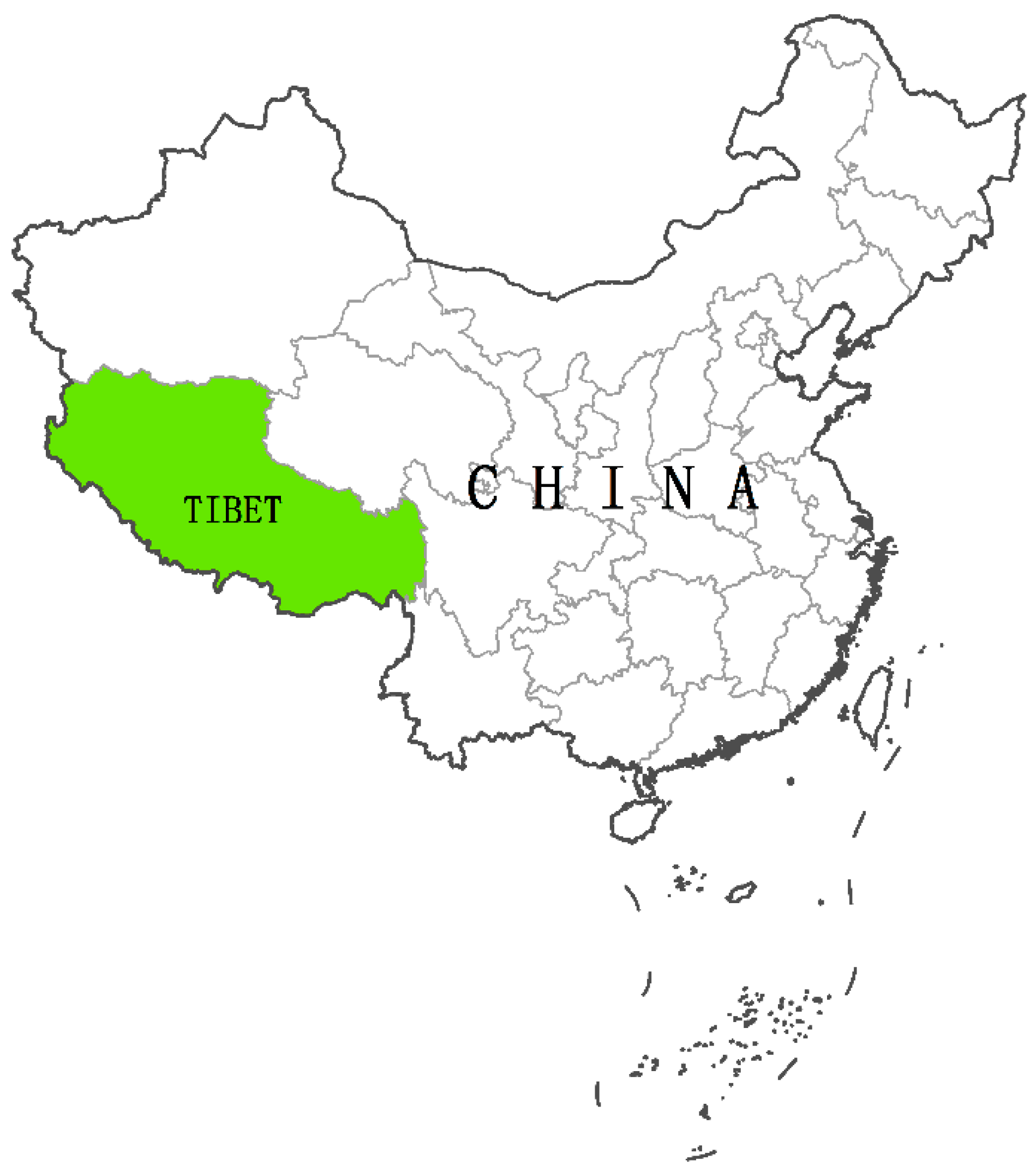
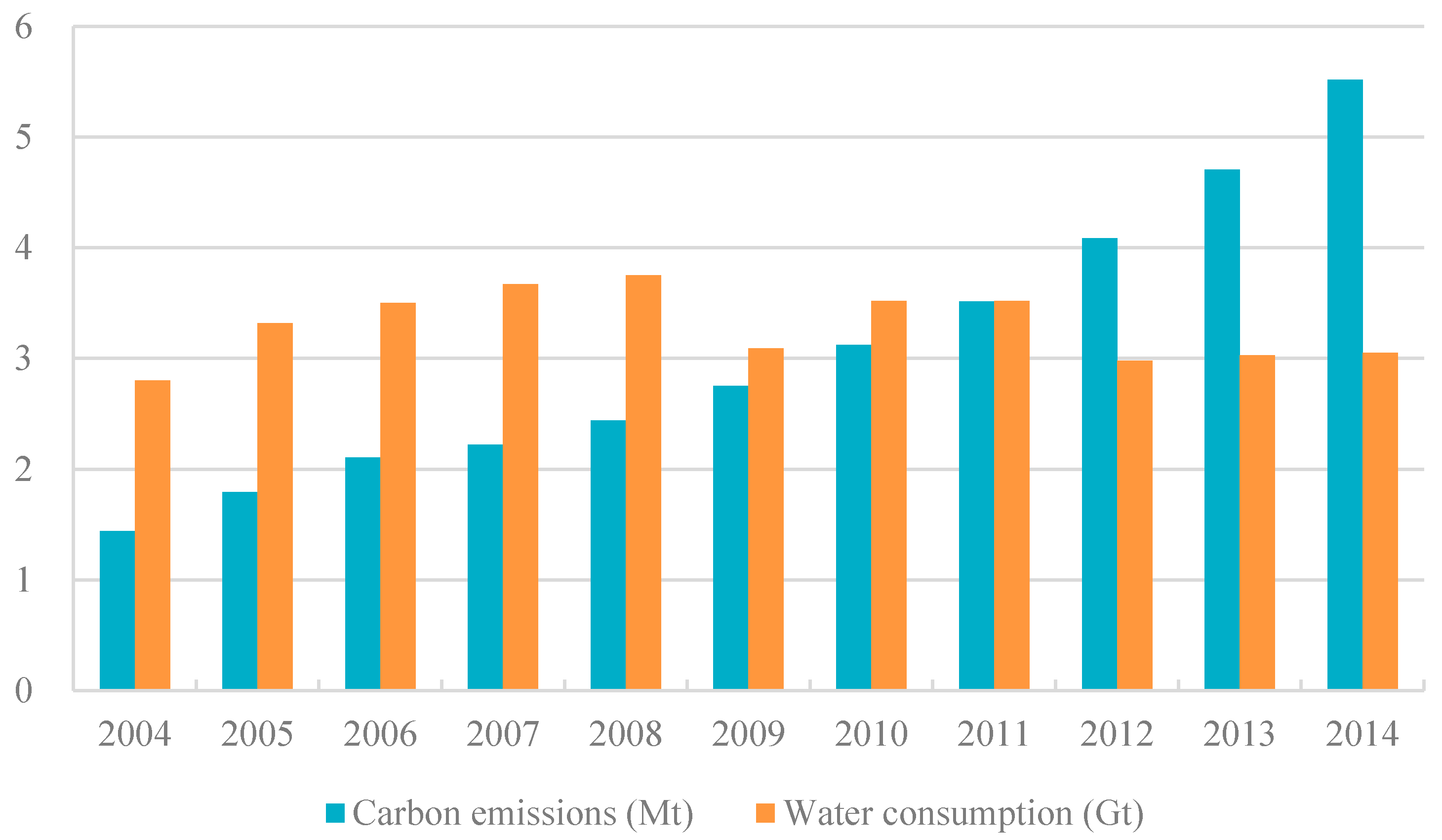
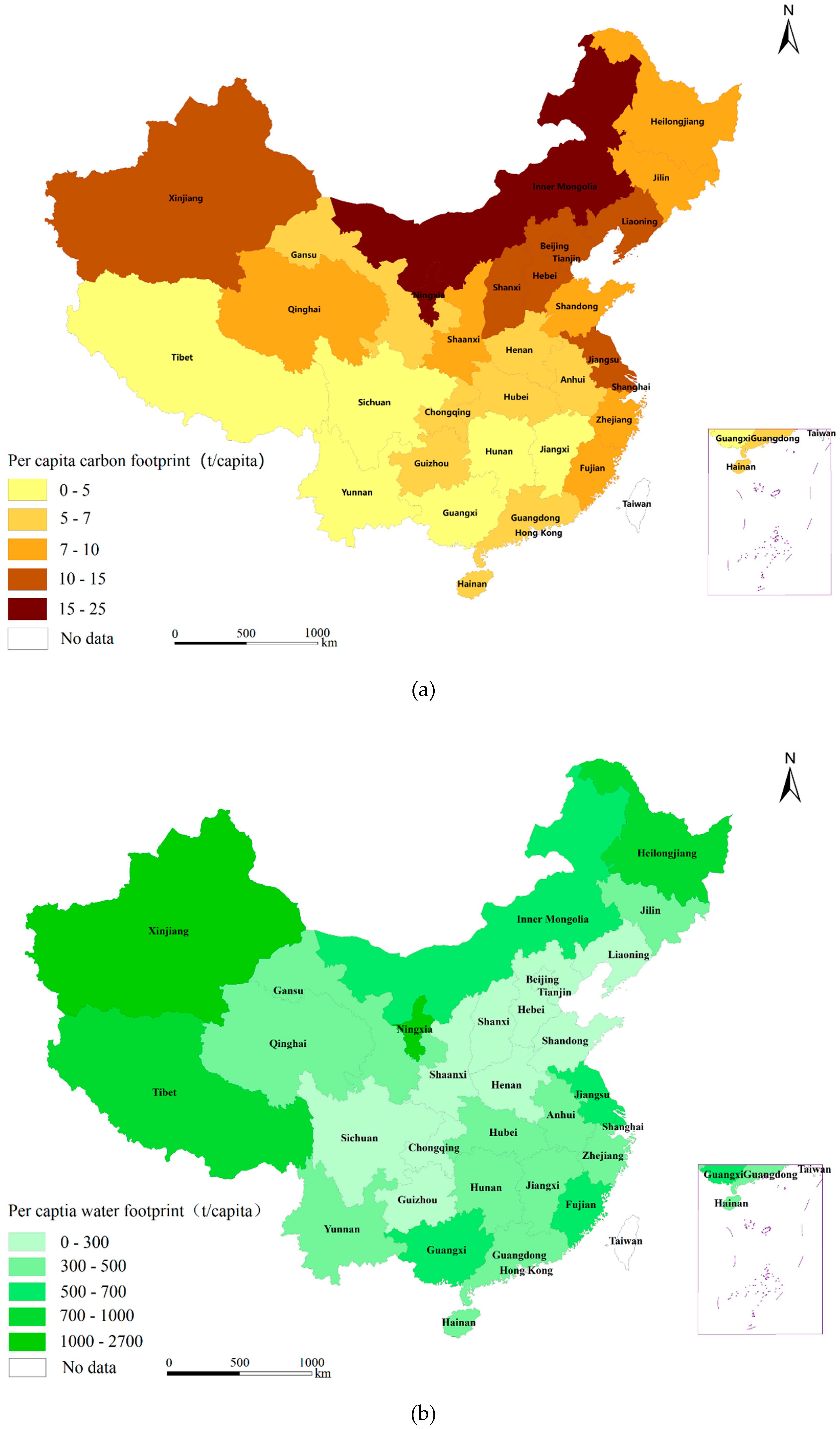
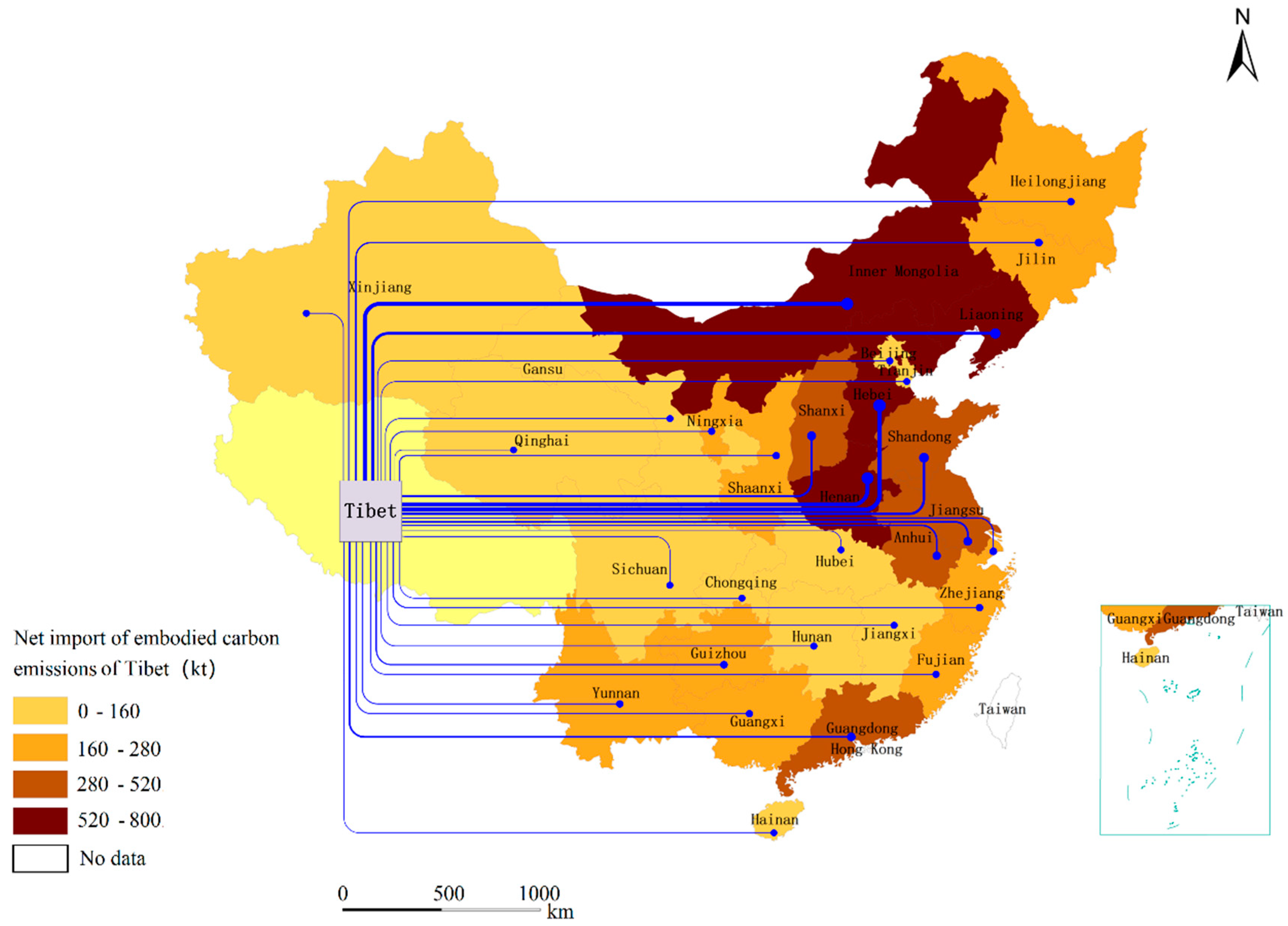
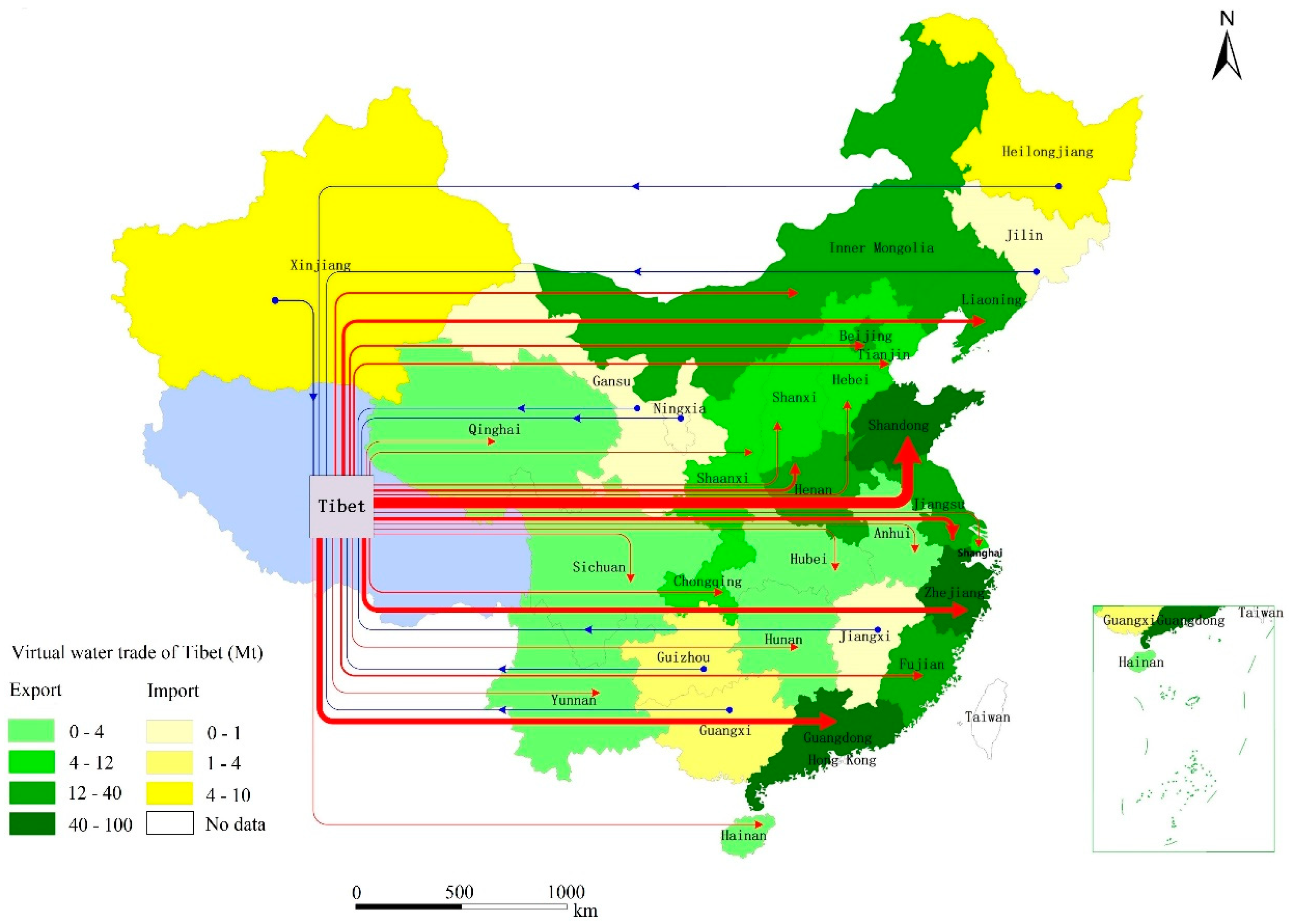
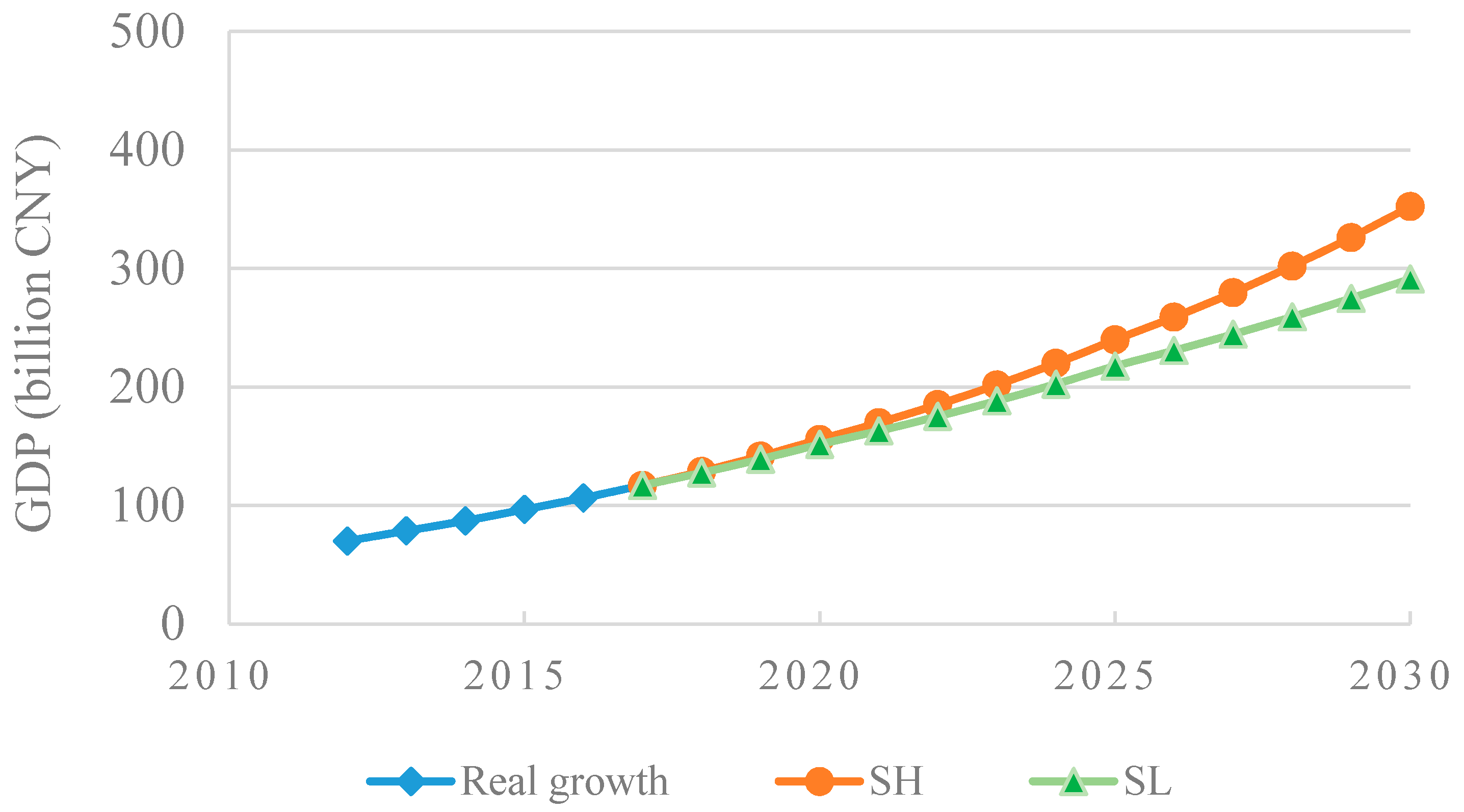
| Code | Sector | Code | Sector | Code | Sector |
|---|---|---|---|---|---|
| S1 | Agriculture | S11 | Petroleum refining coking and nuclear fuel | S21 | Other manufacturing |
| S2 | Coal mining and processing | S12 | Chemical industry | S22 | Electricity and hot water production and supply |
| S3 | Crude petroleum and natural gas | S13 | Non-metallic mineral products | S23 | Gas and water production and supply |
| S4 | Metal ore mining | S14 | Metal smelting and processing | S24 | Construction |
| S5 | Non-metallic minerals and other mining | S15 | Metal products | S25 | Transportation and warehousing |
| S6 | Food processing and tobaccos | S16 | General and specialist machinery | S26 | Wholesale and retailing |
| S7 | Textile | S17 | Transport equipment | S27 | Hotel and restaurant |
| S8 | Clothing, leather, fur, etc. | S18 | Electrical equipment | S28 | Leasing and commercial services |
| S9 | Wood processing and furnishing | S19 | Electronic equipment | S29 | Scientific research |
| S10 | Paper making, printing, stationery, etc. | S20 | Instrument and meter | S30 | Other services |
| Ranking | Sector | Carbon Footprint (kt) | Sector | Water Footprint (Mt) |
|---|---|---|---|---|
| 1 | Construction | 8118 | Agriculture | 1738 |
| 3 | Residents and other services | 2721 | Construction | 368 |
| 4 | Transportation and warehousing | 341 | Residents and other services | 170 |
| 5 | Wholesale and retailing | 233 | Food processing and tobaccos | 148 |
| 6 | Agriculture | 201 | Hotel and restaurant | 56 |
| 7 | Electricity and hot water production and supply | 143 | Chemical industry | 20 |
| 8 | Food processing and tobaccos | 100 | Wholesale and retailing | 15 |
| 9 | Non-metallic mineral products | 98 | Transportation and warehousing | 15 |
| 10 | Hotel and restaurant | 91 | Paper making, printing, stationery, etc. | 9 |
| 11 | Scientific research | 46 | Textile | 8 |
| 12 | Leasing and commercial services | 34 | Wood processing and furnishing | 5 |
| 13 | Metal ore mining | 28 | Scientific research | 4 |
| 14 | Paper making, printing, stationery, etc. | 25 | Metal ore mining | 4 |
| 15 | Chemical industry | 14 | Non-metallic mineral products | 3 |
| 16 | Metal products | 9 | Electricity and hot water production and supply | 2 |
| 17 | Textile | 8 | Clothing, leather, fur, etc. | 2 |
| 18 | Wood processing and furnishing | 6 | Leasing and commercial services | 1 |
| 19 | Clothing, leather, fur, etc. | 4 | ||
| 20 | Gas and water production and supply | 3 | ||
| Total | 12,224 | Total | 2568 |
| Large Water Flow | Small Water Flow | |
|---|---|---|
| Large Carbon Flow | Type 1: Carbon–water complementation Provinces: Liaoning, Inner Mongolia, Henan, Shandong, Guangdong, Jiangsu | Type 2: Carbon sources Provinces: Hebei, Jilin, Shanxi, Anhui |
| Small Carbon Flow | Type 3: Water destination Provinces: Tianjin, Beijing, Zhejiang, Fujian | Type 4: Weak ties in carbon and water trade Provinces: Qinghai, Ningxia, Gansu, Heilongjiang, Xinjiang, Shaanxi, Shanghai, Hubei, Sichuan, Chongqing, Jiangxi, Hunan, Guizhou, Yunnan, Guangxi, Hainan |
| Period | Carbon Intensity | Water Intensity | ||
|---|---|---|---|---|
| Tibet | China | Tibet | China | |
| 2012–2015 | −6.1% ① | −10.6% ② | −22.8% ① | −20.0% ④ |
| 2016–2020e | −12.0% ③ | −18.0% ③ | −35.0% ① | −23.0% ④ |
| 2021–2025e | −12.0% | −18.0% | −30.0% | −20.0% |
| 2026–2030e | −12.0% | −18.0% | −25.0% | −20.0% |
| Year | Carbon Intensity (t/103CNY) | Water Intensity (t/103CNY) | ||
|---|---|---|---|---|
| Tibet | China | Tibet | China | |
| 2012 | 0.063 | 0.166 | 42.52 | 10.43 |
| 2015 | 0.059 | 0.149 | 32.84 | 8.35 |
| 2020e | 0.052 | 0.122 | 21.34 | 6.43 |
| 2025e | 0.046 | 0.100 | 14.94 | 5.14 |
| 2030e | 0.040 | 0.082 | 11.21 | 4.11 |
| 2012 | 2015 | 2020 | 2025 | 2030 | |||||
|---|---|---|---|---|---|---|---|---|---|
| SH | SL | SH | SL | SH | SH | ||||
| Carbon (Mt) | Direct emissions | 4.43 | 5.73 | 8.13 | 7.91 | 11.01 | 10.00 | 14.24 | 11.77 |
| Net inflow | 7.80 | 9.45 | 12.37 | 12.04 | 15.47 | 14.04 | 18.48 | 15.28 | |
| Footprint | 12.23 | 15.18 | 20.50 | 19.95 | 26.48 | 24.04 | 32.72 | 27.05 | |
| Water (Gt) | Direct consumption | 2.99 | 3.08 | 2.93 | 2.85 | 3.16 | 2.87 | 3.48 | 2.88 |
| Net inflow | −0.36 | −0.38 | −0.39 | −0.38 | −0.42 | −0.38 | −0.46 | −0.38 | |
| Footprint | 2.63 | 2.70 | 2.54 | 2.47 | 2.74 | 2.49 | 3.02 | 2.50 | |
© 2020 by the authors. Licensee MDPI, Basel, Switzerland. This article is an open access article distributed under the terms and conditions of the Creative Commons Attribution (CC BY) license (http://creativecommons.org/licenses/by/4.0/).
Share and Cite
Xie, W.; Hu, S.; Li, F.; Cao, X.; Tang, Z. Carbon and Water Footprints of Tibet: Spatial Pattern and Trend Analysis. Sustainability 2020, 12, 3294. https://doi.org/10.3390/su12083294
Xie W, Hu S, Li F, Cao X, Tang Z. Carbon and Water Footprints of Tibet: Spatial Pattern and Trend Analysis. Sustainability. 2020; 12(8):3294. https://doi.org/10.3390/su12083294
Chicago/Turabian StyleXie, Wu, Shuai Hu, Fangyi Li, Xin Cao, and Zhipeng Tang. 2020. "Carbon and Water Footprints of Tibet: Spatial Pattern and Trend Analysis" Sustainability 12, no. 8: 3294. https://doi.org/10.3390/su12083294
APA StyleXie, W., Hu, S., Li, F., Cao, X., & Tang, Z. (2020). Carbon and Water Footprints of Tibet: Spatial Pattern and Trend Analysis. Sustainability, 12(8), 3294. https://doi.org/10.3390/su12083294






